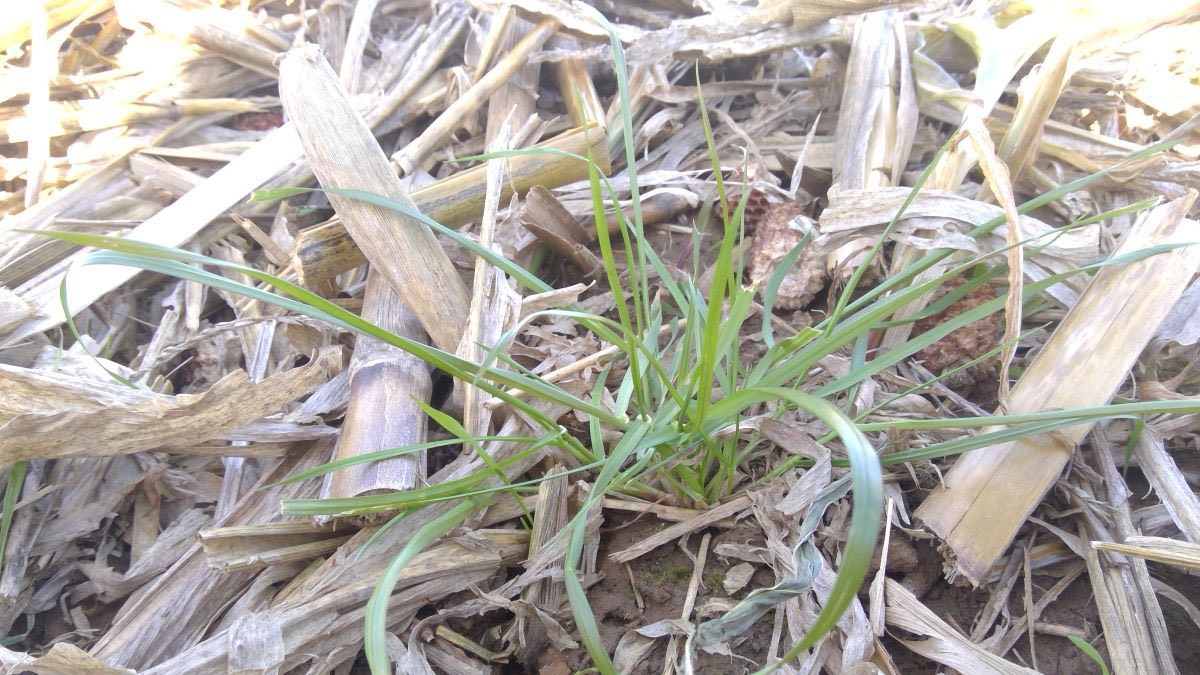Evaluation of Italian Ryegrass Control Prior to Corn
Evaluation of Italian Ryegrass Control Prior to Corn

OBJECTIVE
Italian ryegrass (annual ryegrass) has traditionally been a problematic weed in Kentucky wheat acres and still proves to be a major pest in that crop today. Although, over the past several years the number of complaints of ryegrass escapes in corn has been increasing, with a dramatic in crease in complaints over the past three years. The increase in complaints of ryegrass failures can potentially be attributed to a couple of factors: increased occurrence of herbicide resistance (glyphosate) and unfavorable spring weather conditions.
Multiple populations have been confirmed with glyphosate resistance since 2017, including populations in Pulaski and Simpson County. The occurrence of glyphosate-resistant Italian ryegrass in Kentucky was inevitable, and widespread resistance across Kentucky corn, soybean, and wheat acres is possible in the near future.
Italian ryegrass must be controlled prior to corn planting, as options become limited once the corn crop emerges, especially if the ryegrass is glyphosate resistant. Previous research has revealed that 1.5 lb glyphosate plus saflufenacil is the most effective burndown treatment for ryegrass. Although all herbicide burndown applications for ryegrass are maximized when temperatures are above 45°F for two days prior to and after the application, as well as when ryegrass is less than six inches in height, and when soil conditions allow for sprayer traffic. The alignment of these three conditions can be rare in some Kentucky springs, making an effective spring burndown extremely difficult.
In the face of increasing glyphosate resistance and unpredictable spring weather, alternative options need to be explored. There has recently been a push to use fall residual applications for suppression of ryegrass emergence in the fall. This practice allows for an additional herbicide option and controls ryegrass at emergence when it is easiest to control. Initial research in 2022 showed that fall residuals are effective at suppressing ryegrass emergence and increasing likelihood of control prior to corn planting is increased. Unfortunately, this research also revealed that fall applications result in bare soil throughout the winter months, which is prone to erosion events.
A second year of research was established at the University of Kentucky Research and Education Center in Princeton, Kentucky, in 2023 to evaluate fall-applied soil residual herbicides for suppression of Italian ryegrass emergence and its interaction with cereal rye and wheat as cover crops.
METHODS & MATERIALS
A research trial was initiated at the University of Kentucky Research and Education Center in Princeton, KY, in the fall of 2023, evaluating fall residual herbicide applications for ryegrass control and establishment of wheat and cereal rye cover crops. The study included Zidua, Anthem Maxx, Dual II Magnum, and Boundary applied with glyphosate at the time of cover crop planting. Additional treatments were applied after cover crop emergence and included: Axiom, Boundary, and a tank mix of Zidua and metribuzin. Residual herbicide products were selected based on having either a federal or Kentucky 24c label that allows for the use of the product in the fall for Italian ryegrass control. A complete list of these products and the labeling parameters is listed in Table 1. Applications of the “at cover crop planting” treatments were applied on November 10, 2023, and cover crops were planted on November 15, 2023. The postemergence treatments were applied to 2 leaf cover crops on February 20, 2024. A non-cover crop with each herbicide treatment was also included.
Visual evaluations of percent ryegrass control in comparison to an untreated check were taken on March 14, 2024. Additionally, a visual estimate of cover crop injury was taken on March 14, 2024.
All data were subjected to analysis of variance using PROC GLIMMIX in SAS 9.4. Means separation was conducted using Tukey HSD with an alpha of 0.05.
RESULTS AND DISCUSSION
Similar to results from the 2023 trial the use of products containing pyroxasulfone (Zidua, An them Max) or S-metolachlor (Boundary and Dual II Magnum) applied in the fall resulted in re duced ryegrass emergence and increased control of ryegrass in the spring as compared to the non-residual treatment (Figure 1). The applications on Axiom, Boundary, and Zidua plus metribuzin applied after cover crop emergence all resulted in 88 to 100% control of ryegrass in March when a cover crop was present (Figure 1). The combination of a wheat or rye cover crop and a residual herbicide, either applied at planting of after cover crop emergence resulted great er than 88% control of ryegrass (Figure 1).
Cover crop injury was minimal for both species of cover crop: wheat and cereal rye. Minimal in jury was found across the entire trial was noted, with the greatest occurring with Boundary ap plied at planting at 5% injury (Figure 2). This level of injury is negligible and would not reduce the potential of the cover crop to prevent soil erosion.
CONCLUSION
The use of a fall applied residual herbicide that contains either pyroxasulfone (Zidua or Anthem Maxx), S-metolachlor (Dual II Magnum or Boundary) or metolachlor (Helmet MTZ) can reduce ryegrass populations in a field the following spring. This suppression of ryegrass population in the spring can be a significant benefit, especially when spring weather does not allow for timely burndown applications. As all residual herbicides tested were successful, a farmer can select any of these products with the understanding that the products tested had either a federal or Kentucky 24c label allowing for application in the fall for Italian ryegrass control. Always check the status of 24c labels and federal labels to ensure the product is allowed to be applied in the fall, especially generic S-metolachlor and metolachlor products.
While the benefits of a fall residual herbicide application are obvious with respect to Italian ryegrass control, the downfall of this practice is the potential for increased soil erosion. This research showed that cereal rye or wheat could be planted as a cover crop to provide reduced erosion potential and have minimal injury from the herbicides applied. It would be suggested that since these two cover crops can produce a high amount of biomass, they be terminated in the early spring with a glyphosate application prior to biomass accumulation and corn planting.
ACKNOWLEDGEMENTS
We would like to thank the Kentucky Corn Growers Association for their support of this research.
TABLES




Citation: Legleiter, Travis. (2024). Evaluation of Italian Ryegrass Control Prior to Corn.
University of Kentucky Research and Education Center. First published in the 2024 UK Corn Research Report.
